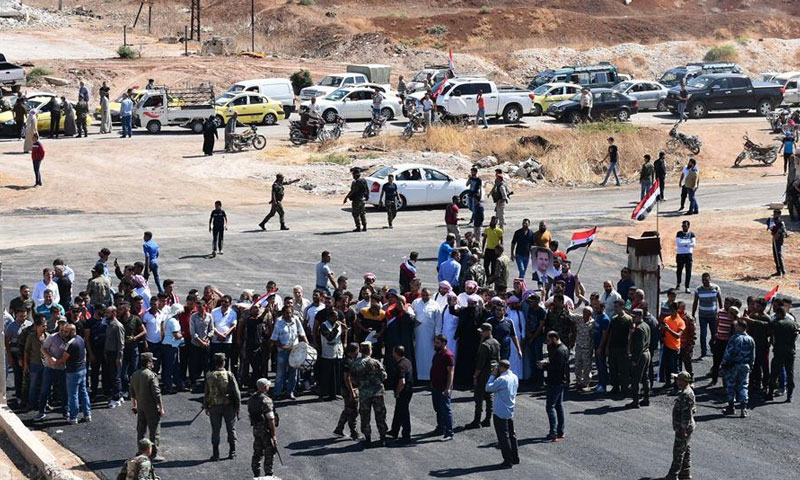



Following the same scenario it adopted in Daraa, Eastern Ghoutah and northern rural Homs, the Syrian regime has in the past few days promoted for the return of ‘hundreds of families’ to their houses in the city of Murak, northern rural Hama, in addition to those in the city of Khan Shaykhun, after it controlled the full range of the area through a military offensive it embarked on backed by Russia.
Official media outlets published photos and videos of dozens of vehicles, on which the ‘Syrian flag’ and pictures of the head of the Syrian regime, Bashar al-Assad, were raised, titling the scene as the “people’s joy over returning to their houses, which have been purged of terrorists.”
The houses referred to in the title are all completely destroyed by the aerial, artillery and missile shelling that lead the regime forces and their Russian ally to the area.
Prior to promoting for the people’s return, the Syrian regime declared the opening of two ‘humanitarian’ corridors— the first is Abu Ad- Dhuhur crossing, eastern rural Idlib, and the second is Murak crossing, which the Syrian regime forces have opened and closed several times before. The crossings are meant to attract civilians, based in the opposition factions-held areas and lure them to exit towards the regime-controlled ones.
Mohammad Shahoud, a former school principal in the city of Murak, told Enab Baladi that the statements made by the Syrian regime on the residents’ return and the promotional campaign all fall within its efforts to realize media and political gains.
“The families have not been back at Murak to the day. What is happening is that demonstrations are being held, consisting of locals and employees, seeking only to achieve media and political benefits,” he said, pointing out that “for the locals to return to Murak, security guarantees must be made available, represented by the regime forces’ withdrawal from the city, on the condition that Murak stays neutral under the supervision of the Turkish observation post set up in it.”
“Trust between the regime and locals is lacking, for former experiences are many,” Shahoud added.
The city of Murak is in northern rural Hama, on the Damascus-Aleppo International Highway. Even though the Syrian regime and Russia have totally taken over the city, the Turkish forces are yet stationed in the observation post established in the area earlier on.
Abdulsalam Abu Qassem, assigned the presidency of the Murak Local Council, told Enab Baladi that Murak has already been declared an afflicted city, considering the intensive shelling that targeted it and coerced all its residents to depart towards other areas in rural Idlib.
A number of the families, Abu Qassem added, whom the Syrian regime announced as have returned from the areas it controls, “were forced to return as to appear in the videos without being capable of staying in the houses.”
He said that the locals of Murak refuse to head back to their city, which the Syrian regime forces have controlled last August.
The Murak Local Council continues to provide its services in the city of Idlib, following the Syrian regime’s control of Murak on the last offensive.
Commenting on the reopening of the Murak crossing, Abu Qassem said that it has been activated “to allow [regime] agents in the city as to implement its schemes,” stressing that, “since they entered Murak, the regime forces have been stealing the pistachio crops and logging the olive trees, to sell them as firewood.”
In a report, published in early September, the UN accused the Syrian regime, Russia and the US-led coalition of committing crimes against Syrian civilians, which amount to ‘war crimes.’
The UN has also approached the last offensive launched by the Syrian regime, covered by Russia, on northern rural Hama and southern rural Idlib since last April, pointing out that it took a toll on hundreds of civilians and triggered the displacement of more than 330 thousand persons.
The Syria Response Coordination Group (SRCG) said that the Syrian regime is imposing pressure on the civilians in Idlib province, as to coerce them into leaving to the areas it controls.
In a statement published on September 12, the SRCG said that the regime forces promoted for the reopening of the Abu Ad-Dhuhur crossing for the civilians in a step to urge them to abandon their areas for the regime-held areas.
The Group added that announcing the reopening of the Abu Ad-Dhuhur crossing is part of the propaganda run by the Syrian regime-affiliated media outlets.
if you think the article contain wrong information or you have additional details Send Correction